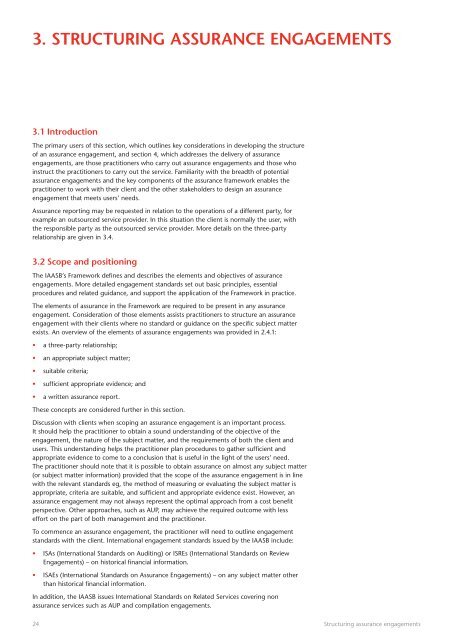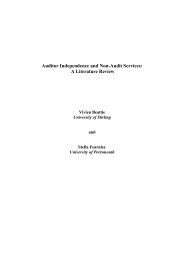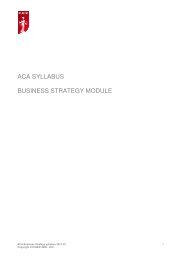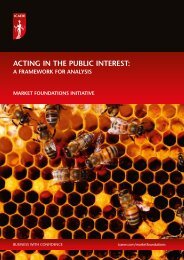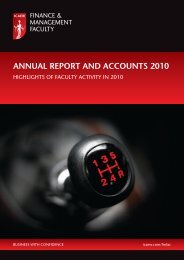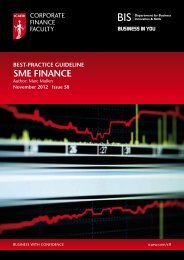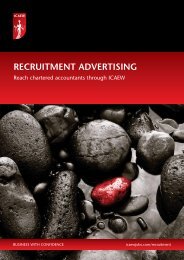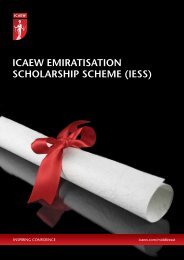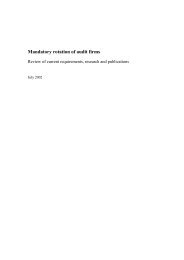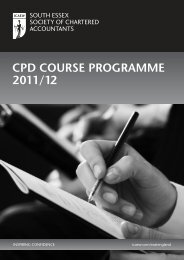3. STRUCTURING ASSURANCE ENGAGEMENTS - ICAEW
3. STRUCTURING ASSURANCE ENGAGEMENTS - ICAEW
3. STRUCTURING ASSURANCE ENGAGEMENTS - ICAEW
- No tags were found...
You also want an ePaper? Increase the reach of your titles
YUMPU automatically turns print PDFs into web optimized ePapers that Google loves.
<strong>3.</strong> <strong>STRUCTURING</strong> <strong>ASSURANCE</strong> <strong>ENGAGEMENTS</strong><strong>3.</strong>1 IntroductionThe primary users of this section, which outlines key considerations in developing the structureof an assurance engagement, and section 4, which addresses the delivery of assuranceengagements, are those practitioners who carry out assurance engagements and those whoinstruct the practitioners to carry out the service. Familiarity with the breadth of potentialassurance engagements and the key components of the assurance framework enables thepractitioner to work with their client and the other stakeholders to design an assuranceengagement that meets users’ needs.Assurance reporting may be requested in relation to the operations of a different party, forexample an outsourced service provider. In this situation the client is normally the user, withthe responsible party as the outsourced service provider. More details on the three-partyrelationship are given in <strong>3.</strong>4.<strong>3.</strong>2 Scope and positioningThe IAASB’s Framework defines and describes the elements and objectives of assuranceengagements. More detailed engagement standards set out basic principles, essentialprocedures and related guidance, and support the application of the Framework in practice.The elements of assurance in the Framework are required to be present in any assuranceengagement. Consideration of those elements assists practitioners to structure an assuranceengagement with their clients where no standard or guidance on the specific subject matterexists. An overview of the elements of assurance engagements was provided in 2.4.1:• a three-party relationship;• an appropriate subject matter;• suitable criteria;• sufficient appropriate evidence; and• a written assurance report.These concepts are considered further in this section.Discussion with clients when scoping an assurance engagement is an important process.It should help the practitioner to obtain a sound understanding of the objective of theengagement, the nature of the subject matter, and the requirements of both the client andusers. This understanding helps the practitioner plan procedures to gather sufficient andappropriate evidence to come to a conclusion that is useful in the light of the users’ need.The practitioner should note that it is possible to obtain assurance on almost any subject matter(or subject matter information) provided that the scope of the assurance engagement is in linewith the relevant standards eg, the method of measuring or evaluating the subject matter isappropriate, criteria are suitable, and sufficient and appropriate evidence exist. However, anassurance engagement may not always represent the optimal approach from a cost benefitperspective. Other approaches, such as AUP, may achieve the required outcome with lesseffort on the part of both management and the practitioner.To commence an assurance engagement, the practitioner will need to outline engagementstandards with the client. International engagement standards issued by the IAASB include:• ISAs (International Standards on Auditing) or ISREs (International Standards on ReviewEngagements) – on historical financial information.• ISAEs (International Standards on Assurance Engagements) – on any subject matter otherthan historical financial information.In addition, the IAASB issues International Standards on Related Services covering nonassurance services such as AUP and compilation engagements.24Structuring assurance engagements


